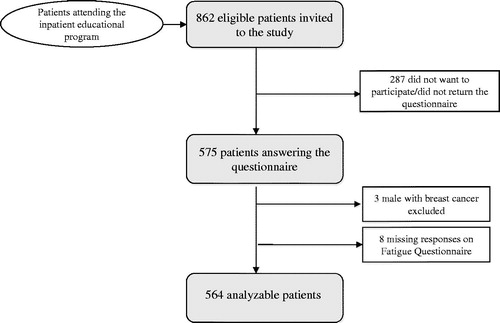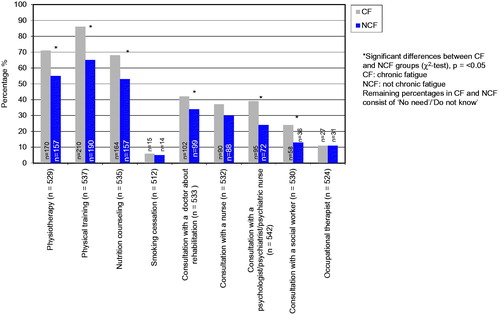Abstract
Background: Knowledge about the user’ needs is important to develop targeted rehabilitation for cancer patients with chronic fatigue (CF). The aims of the study were to examine prevalence of CF in cancer survivors attending an one-week inpatient educational program (IEP) and to identify characteristics of those with CF. Further to examine the perceived needs for different components in a rehabilitation program, need of complex rehabilitation (at least two components) and aspects of health-related quality of life (HRQoL) among survivors with CF versus those without CF.
Material and methods: Cancer survivors ≥18 years, diagnosed with different types of cancer within the last 10 years and attending a one-week IEP were invited to this cross-sectional study. CF was assessed by the Fatigue Questionnaire, perceived needs by asking a question about needs for different components in a rehabilitation program and HRQoL was assessed by The Medical Outcomes Study Short Form 36.
Results: Of 564 participants, 45% reported CF. Breast cancer, mixed cancer types (including small groups with different cancer types) and comorbidities increased the risk for having CF. Compared to participants without CF, the participants with CF reported more frequently need for physical training (86% vs. 65%, p < 0.001), physiotherapy (71% vs. 55%, p < 0.001) and nutrition counseling (68% vs. 53%, p = 0.001). Among participants with CF, 75% reported need for three or more components whereas 54% reported need for the same number of components among those without CF (p < 0.001).
Conclusion: Almost half of the cancer survivors attending the IEP had CF. Physical training, physiotherapy and nutrition counseling were the most frequently reported needs and significantly more often observed in participants with CF than without CF. A higher percentage of those with CF reported need for a complex rehabilitation compared to those without CF. More research is necessary to obtain more knowledge to further make targeted programs to better match cancer survivors’ needs.
Fatigue is a frequent and distressing symptom among cancer patients both during and after treatment [Citation1,Citation2]. A modified definition from National comprehensive cancer network define cancer-related fatigue as: ‘a distressing, persistent, subjective sense of physical, emotional, and/or cognitive tiredness or exhaustion related to cancer and/or cancer treatment that is not proportional to recent activity and interferes with usual functioning’ [Citation3]. Fatigue affects the patients’ ability to perform normal daily activities and is not relieved by sleep and rest [Citation4]. The different levels of fatigue extent from no fatigue to mild to moderate to severe fatigue [Citation3]. The level of fatigue and prevalence of chronic fatigue (CF) (substantial fatigue for ≥6 months) [Citation5] have been shown to be higher among cancer survivors (25–39%) than in the general population (11%) several years after treatment [Citation6–11]. Studies among cancer survivors attending a rehabilitation program have also showed that the participants suffer from higher levels of fatigue [Citation12,Citation13] compared to age- and gender-matched healthy controls [Citation14]. Fatigue in cancer survivors has been associated with several somatic and psychological factors, such as comorbidities, increased level of inflammatory cytokines and treatment-related discomfort and high body mass index [Citation1,Citation2,Citation11]. Further, studies have found that cancer survivors with CF experience deconditioning, impaired HRQoL including physical-, psychological-, social- and cognitive functioning, and reduced work ability [Citation3,Citation15–18].
In general, the content and complexity of rehabilitation among cancer survivors varies depending on cancer diagnosis, treatment, late effects and general health, but also personality, coping strategies, life situation, work and social network might also influence the needs [Citation19,Citation20]. In a study among Norwegian cancer survivors, the need for physiotherapy and physical training were most frequently reported, almost two thirds were in need for at least one rehabilitation service and 40% were in need of complex rehabilitation defined as need of at least two rehabilitation services [Citation21]. A Canadian study of women with gynecologic cancer showed that the most frequently reported needs were non-physical [Citation22], while a Danish population-based cohort study of cancer survivors found that needs for physical and psychological rehabilitation were equally frequent [Citation23].
The potential costs of CF, in terms of impact on economy, occupational and healthcare resources [Citation24], emphasize even more the importance of rehabilitation. As CF is associated with several physical and mental health problems, as well as impaired HRQoL and reduced work status, it is reasonable to assume that patients struggling with CF are in need of several (at least two) components in a rehabilitation program (complex rehabilitation) compared to cancer survivors without CF. However, knowledge about what components that are most relevant and which to be included in a rehabilitation program for these cancer survivors with CF and if they are in need for a complex rehabilitation are to our best knowledge not studied previously. In order to improve the function and HRQoL among cancer survivors suffering from CF, it is of high importance to make targeted programs that meet the specific needs that those cancer survivors report.
On this background the aims of the present study were to: (1) examine the prevalence of CF in cancer survivors attending a one-week inpatient educational program (IEP) and to identify characteristics of those with CF; (2) examine the perceived needs for different components in a rehabilitation program among survivors with CF as compared to those without CF; (3) estimate the need for complex rehabilitation, in terms of need for several components, among survivors with CF as compared to those without CF and to (4) examine aspects of health-related quality of life (HRQoL) within number of needs among survivors with CF as compared to those without CF.
Material and methods
Design and participants
The present cross-sectional study was part of a prospective study of participants who attended a one-week IEP at The Norwegian Resource Center for Coping with Cancer [The Montebello-Center (MBC)] in the period September 2011 through February 2013. Inclusion criteria were: age ≥18 years, diagnosed with cancer within the last 10 years, and attending the IEP. Additionally, MBC had as a general routine that participants needed to be referred ahead of the program by a medical doctor confirming a ‘need for the program’ (without further criterion) and the participants had to manage daily routines without assistance due to limited resources at MBC. There were no exclusion criteria.
Educational programs at Montebello-Center
The IEPs lasting one week were specific for each cancer type but with most of the components common across the programs. Patients with identical diagnoses attended therefore the same week. Patients with less frequent cancer type attended together in the week with mixed diagnoses. Various professionals including an oncologist, nurse, social worker, psychologist, nutritionist and physiotherapist/sports instructor led the different parts of the program. During the six-day program the participants had multidisciplinary lectures, group discussions and participated in physical activities, such as outdoor walking, water gymnastics or physical exercises in the gym. In addition to lectures about the cancer, its treatment, risk of late effects and other topics, most participants received one lecture about physical activity and one practical session on nutrition and cooking. The programs aimed to improve the participants’ coping with specific cancer-related health problems, as well as providing information aiming to inspire and focus on opportunities for adopting a healthy lifestyle.
Ethical considerations
The South-East Regional Committee for Medical and Health Research Ethics and the Institutional Review Board of Oslo University Hospital approved the study. All participants provided written consent forms.
Measurements
On the day of arrival, the participants were informed about the study and received an information letter, a written consent form and a questionnaire. Those willing to participate in the study returned the completed questionnaire and a signed consent form before the program started, at the latest on the following day.
Background variables
Background variables were self-reported and included gender, age at survey, civil status (living alone/living together), level of education [≤12 years (low level)/>12 years (high level)], work status (full-time/part-time/retired/disability benefit or social support), cancer diagnosis [prostate cancer/breast cancer/gastrointestinal cancer/mixed group (including small groups with different cancer types: gynecological cancer/lung cancer/neuroendocrine tumor/head and neck cancer/lymphoma/brain cancer/myeloma/sarcoma/leukemia/cancer of the urinary tract/testicular cancer and others)], time since diagnosis, previous treatment [non-systemic (including surgery and/or radiotherapy)/systemic (including chemotherapy and/or hormone therapy ± surgery and/or radiotherapy)], relapse of cancer (no/yes), comorbidity (no/yes) [defined as any long-lasting (at least one year) physical and/or psychological conditions which had led to reduced daily functioning], meet physical activity guidelines [≥150 minutes of moderate intensity physical activity or 75 minutes of high intensity physical activity per week [Citation25] (no/yes), current smoking (no/yes) and body mass index (kg/m2)] [healthy (<25)/overweight or obese (≥25)].
Fatigue
Fatigue was assessed by the Fatigue Questionnaire (FQ) [Citation5] which consists of 11 items; of which seven items on physical fatigue (PF) and four items on mental fatigue (MF). Each item has four response alternatives scored 0–3 (Likert scores). The scores are summarized for calculation of PF (range 0–21) and MF (range 0–12). Total fatigue score is the sum of PF and MF (range 0–33). Higher scores imply higher levels of fatigue. The questionnaire also asks for the duration of fatigue. A dichotomized score (0–1 = 0 and 2–3 = 1) is used for the definition of CF, which is defined as a sum of the dichotomized scores of 4 or higher and duration for 6 months or longer [Citation5]. The duration of 6 months is not consensus-based but commonly used to define chronicity across medicine. With respect to CF, the 6 months’ duration is used to be in line with the definition of the CF syndrome. The FQ has good to very good psychometric properties [Citation26]. In the present sample, Cronbach’s alpha measuring internal consistency was 0.89 for the total fatigue score.
Perceived needs for different components within a rehabilitation program
The participants were asked about their perceived needs for nine different components in a rehabilitation program: physiotherapy, physical training, nutrition counseling, smoking cessation, consultation with a doctor about rehabilitation, consultation with a nurse, consultation with a psychologist/psychiatrist/psychiatric nurse, consultation with a social worker and occupational therapist. For each component the response alternatives were: Yes, I have a current need/No, I do not have a current need/Do not know if I have a current need. The questions were modified from a previous survey, pilot-tested for clarity and understandability, and subsequently slightly adjusted [Citation21]. Complex rehabilitation was defined as need for two or more components. We summarized the number of components each participant reported need for (response range: 0–9). Thus, a higher number of components reported indicated need for more complex rehabilitation. We categorized this variable into four groups: no need, one need, two needs and three or more needs.
Health-related quality of life (HRQoL)
HRQoL was assessed using The Medical Outcomes Study Short Form 36 (SF-36) [Citation27]. The responses to each question within each of the eight subscales were summed and transformed to 0–100 scales (0 = worst health state, 100 = best health state) according to the manual [Citation27]. Additional to the eight subscales, summary scores for physical health [Physical component scale (PCS)] and mental health [Mental component scale (MCS)] can be calculated. Both the PCS and MCS have a mean score of 50 and standard deviation (SD) of 10 points in the general population [Citation27].
Statistical analyses
Descriptive analyses were used to describe characteristics of the participants. Logistic regression analyses were used to identify variables associated with CF. Variables statistically significant in unadjusted analyses were included as explanatory variables in the multivariate regression analyses. Gender could not be included in the multivariate regression analyses as the two major diagnoses are gender-specific. Adjusted odds ratios (aOR) are presented with 95% confidence intervals (95% CI). χ2-test was applied to assess differences between those with CF and those without CF in need for the specific components and complex rehabilitation. Independent sample t-test was used to assess differences between those with CF and without CF related to PCS and MCS of HRQoL within the different number of components needed. Statistical analyses were performed by using SPSS 21.0 for Windows (SPSS, Chicago, IL, USA). A p-value less than 0.05 was considered as statistical significant.
Results
Patient flow and characteristics
In total 862 eligible patients were invited and 575 agreed to participate in the study. Of these, three male patients treated for breast cancer were excluded. As a result of missing responses on FQ (n = 8), 564 were included in the analysis giving a response rate of 66% (). Demographic and medical characteristics of the participants are presented in .
Figure 5. Proportions of CF and NCF participants perceived need for number of components in a rehabilitation program (n = 552)

Figure 6. (a) Physical component score (PCS) among CF and NCF participants within different need for number of components in a rehabilitation program. (b) Mental component score (MCS) among CF and NCF participants within different need for number of components in a rehabilitation program (n = 525).
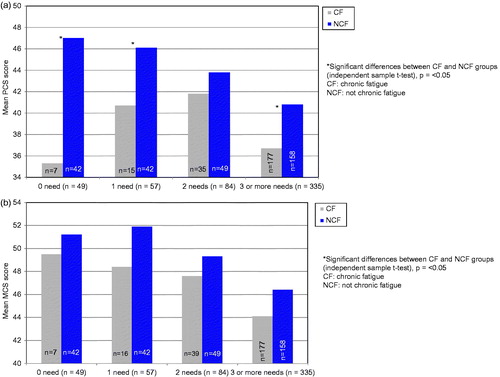
Table 1. Characteristics of the participants (n = 564).
Forty-five percent of the participants reported to have CF (). In univariate analyses, female gender, age <60 years, diagnosis of breast cancer and mixed cancer types, ≥1 year since diagnosis, having received systemic treatment and presence of comorbidities were associated with CF (). Adjusted for age, cancer diagnosis, time since diagnosis, treatment and comorbidity, multivariate analyses showed that compared to participants treated for prostate cancer, those with breast cancer had about three times higher odds and those in the group of mixed cancer types were almost twice as likely to have CF [aOR 3.09; 95% CI (1.75–5.48), p < 0.001 and aOR 2.02; 95% CI (1.17–3.49), p = 0.01, respectively]. In addition, participants with comorbidities were more than twice as likely to have CF compared to those without comorbidities [aOR 2.2; 95% CI (1.51–3.21), p < 0.001] ().
Figure 2. (a) Prevalence of chronic fatigue (CF) and demographical and medical variables associated with CF (vs. not CF) (n = 564). Numbers may not add up to 564 because of missing data. cOR crude odds ratio. *Mixed group including gynecological cancer (n = 44), lung cancer (n = 26), neuroendocrine tumor (n = 24), head and neck cancer (n = 18), lymphoma (n = 16), brain cancer (n = 15), myeloma (n = 13), sarcoma (n = 6), leukemia (n = 7), cancer of the urinary tract (n = 5), testicular cancer (n = 1) and others (n = 10). **Systemic treatment including chemotherapy and/or hormone therapy ± surgery and/or radiotherapy. Non-systemic treatment including surgery and/or radiotherapy. (b) Prevalence of chronic fatigue (CF) and comorbidity and lifestyle variables associated with CF (vs. not CF) (n = 564). Numbers may not add up to 564 because of missing data. cOR crude odds ratio. BMI: body mass index; PA: physical activity. *PA guidelines include at least 150 minutes of moderate intensity PA or 75 minutes of high intensity PA per week.
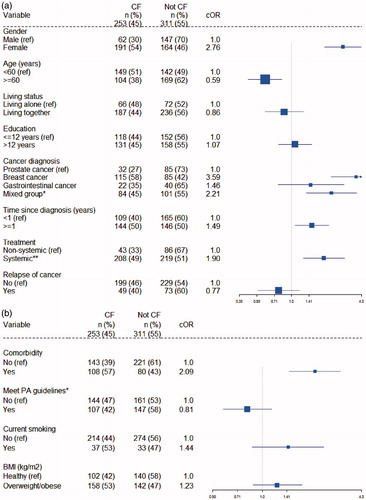
Figure 3. Multivariate regression analyses (n = 544). aOR adjusted odds ratio. *Mixed group including gynecological cancer (n = 44), lung cancer (n = 26), neuroendocrine tumor (n = 24), head and neck cancer (n = 18), lymphoma (n = 16), brain cancer (n = 15), myeloma (n = 13), sarcoma (n = 6), leukemia (n = 7), cancer of the urinary tract (n = 5), testicular cancer (n = 1) and others (n = 10). **Systemic treatment including chemotherapy and/or hormone therapy ± surgery and/or radiotherapy. Non-systemic treatment including surgery and/or radiotherapy.
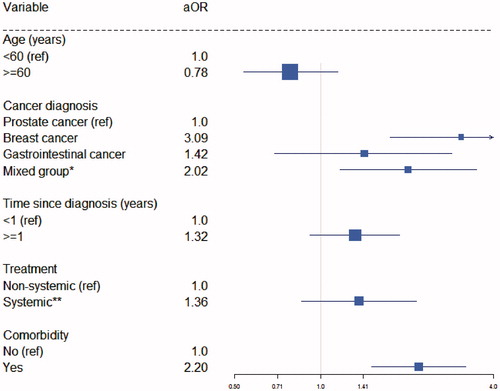
Perceived needs for different components in a rehabilitation program
Compared to participants without CF, there was a higher proportion of participants who reported need for six of nine components among those with CF (). Eighty-six percent of the participants with CF reported need for physical training versus 65% among the participants without CF (p < 0.001) and, in addition, 71% of participants with CF reported need for physiotherapy versus 55% among those without CF (p < 0.001). Sixty-eight percent of participants with CF reported need for nutrition counseling versus 53% among those without CF (p = 0.001) ().
Need for complex rehabilitation
Of all participants with CF, 75% reported need for three or more components versus 54% among the participants without CF (p < 0.001) (). Significantly fewer participants with CF reported no need and one need compared to participants without CF (3% vs. 14%, p < 0.001 and 6% vs. 14%, p < 0.001, respectively) ().
HRQoL and number of components needed in a rehabilitation program
Overall, there was a tendency that those with need for several components in a rehabilitation program had lower PCS and MCS scores compared to those with fewer needs (). Those with CF reported a significant lower PCS score compared to those without CF within the group of no needs (p = 0.004), one need (p = 0.039) and three or more needs (p < 0.001) (). For MCS, there were no such significant differences between those with CF compared to those without CF ().
Discussion
In this study almost half of the participants reported to have CF. Those with breast cancer or mixed cancer types and those with comorbidities had an increased risk for having CF. Close to all of those with CF reported need for physical training compared to two thirds among those without CF. Second and third most frequently reported component were physiotherapy and nutrition counseling. Three quarters of the participants with CF reported need for three or more components in a rehabilitation program, which was more frequent compared to participants without CF. Those with CF reported a lower physical HRQoL compared to those without CF. Overall, there was a tendency that those with need for complex rehabilitation had reduced HRQoL.
Fatigue is a complex symptom and therefore is best measured by a multi-item scale. The numbers of domains in fatigue is disputed, but the two domains in the FQ (mental and physical) [Citation5] seem to be included in most assessment tools. In line with this, fatigue is not a diagnosis and is not listed as such in the International Classification of Diseases (ICD)-10. As for most symptoms, the presence of fatigue does not necessarily indicate pathology.
The prevalence of CF was especially high among the participants with breast cancer (58%), and considerable higher than what is found in cross-sectional studies of breast cancer survivors [Citation11]. In line with our findings, Bertheussen et al. found that cancer survivors (mostly breast cancer diagnosis) attending a three-week inpatient rehabilitation program had similar levels of fatigue than the participants in our study [Citation14]. Holla et al. found that colorectal cancer survivors with higher fatigue scores more often participated in a rehabilitation program consisting of physical activity and psycho-education than survivors without fatigue [Citation28]. When planning different components in such programs the high level of fatigue should be taken into account, especially for specific subgroups such as breast cancer patients with presence of comorbidities. Depression has been shown to be associated with fatigue among breast cancer survivors [Citation11]. Unfortunately, we did not collect any information on depression in the present study. Due to small numbers of different cancer diagnosis within the mixed group it would be difficult to look at them separately without losing statistical power. In future studies a higher number of participants would able the planning of rehabilitation also for the more rare cancer diagnoses.
Our findings imply a strong perceived need for physical training among participants both with CF (86%) and without CF (71%), but significantly more participants with CF reported need for this component. Partly, this might be explained by current knowledge about the beneficial effect of physical activity on fatigue among these participants [Citation29,Citation30], but our results might also indicate that CF is a barrier to get started with physical activity. Physical activity counseling should therefore be a core component in a rehabilitation program for cancer survivors with CF. Our findings that the top two most reported needs were physical training and physiotherapy are supported by a study among cancer survivors (without defined CF), however the numbers on frequency were noteworthy less than in the present study [Citation21]. The top three most needed components were physical training, physiotherapy and nutrition counseling in the whole group, but significantly higher among those with CF than those without CF. Nevertheless, among participants with CF around 40% reported a need for consultation with a doctor or a psychologist/psychiatrist/psychiatric nurse, and that is worth noticing, supporting the need for complex rehabilitation in this subgroup. The frequently reported need for physiotherapy in the present study might be reflected by the overrepresentation of women with breast cancer and their need for physiotherapy due to arm/shoulder problems such as mobility limitations, lymphedema, pain and fibrosis [Citation31,Citation32]. Our observation that CF was associated to comorbidity, could also explain more frequently reported need for physiotherapy among those with CF. In addition, the fact that our sample was overrepresented by highly educated women with breast cancer and these biases could have overestimated the perceived needs for rehabilitation. Previously studies have showed that women more frequently report needs for rehabilitation than men, and those with breast cancer report more needs than those with other types of cancer [Citation21,Citation23].
Contrary to our findings, Steele et al. found that the need for non-physical components was more frequently reported compared to physical components in a group of gynecological cancer during and after treatment [Citation22], however, a small sample size with one single cancer diagnosis and no defined CF could be one of the reasons for the different findings.
As expected, more participants with CF reported a need for complex rehabilitation than those without CF. The high number of participants with CF that reported complex need, suggests that those with CF experience several health issues that they need help with. This assumption is supported by a study of cancer survivors (without defined CF) where only 25% reported need for three or more components [Citation21]. We found that participants with CF had lower PCS scores compare to those without CF, there were no such difference in the MCS scores. This could indicate that CF is more linked to physical than mental impairments, and further could explain the need for physical training more than psychological needs.
The strengths and limitations of our study need to be noted. The response rate was relatively high (66%), the sample size was satisfactory and the use of validated questionnaires for fatigue and HRQoL are a strength. Limitations include the referral system at the MBC that consequently results in a heterogeneous group. We have to be aware that the skewed distribution and the sample of convenience limit the possibility to generalize our results to the broader population of cancer survivors. Information about the patients who did not want to participate in the study was not available, and there is a chance that a selection bias has occurred.
The questions on perceived needs for components in a rehabilitation program have not been formally validated, but pilot-tested for clarity and understandability in a group of cancer survivors at the MBS with subsequent adjustment. We are not sure if the responders understood the exact differences between physiotherapy and physical training or the content of the other components. There were no further explanations or definitions. For some participants, physiotherapy could mean a lymphedema massage treatment or for other it could mean physical training (exercises) with their physiotherapists. To diminish this limitation in the future, a more detailed assessment for these items should be developed. Another limitation is that the nine different components asked for may not be complete. The components used were supposed to cover a broad aspect of needs, including physical, psychological and social needs, but may not be absolute.
Future focus should be more directed towards content in rehabilitation programs offered, in terms of which components are needed among different groups of cancer survivors. Prospective studies are needed in order to investigate the optimal content of rehabilitation programs, as well as to identify cancer survivors that will benefit from different rehabilitation programs.
Conclusions
In conclusion, almost half of the cancer survivors attending the IEP had CF. Breast cancer, mixed cancer types and comorbidities increased the risk for CF. Physical training, physiotherapy and nutrition counseling were the three most reported components needed, significantly more often among participants with CF than without CF. Those with CF more often reported a need for complex rehabilitation, and they reported a lower physical HRQoL compared to those without CF. More research is necessary to obtain more knowledge to further make targeted programs to better match cancer survivors’ needs.
Acknowledgments
The authors wish to acknowledge all patients who participated and the work and collaboration of the staff of the Montebello-Center.
Disclosure statement
The authors report no conflicts of interest. The authors alone are responsible for the content and writing of this article.
Additional information
Funding
References
- Minton O, Berger A, Barsevick A, et al. Cancer-related fatigue and its impact on functioning. Cancer. 2013;119(Suppl 11):2124–2130.
- Minton O, Jo F, Jane M. The role of behavioural modification and exercise in the management of cancer-related fatigue to reduce its impact during and after cancer treatment. Acta Oncol. 2015;54:581–586.
- Bower JE. Cancer-related fatigue-mechanisms, risk factors, and treatments. Nat Rev Clin Oncol. 2014;11:597–609.
- Bardwell WA, Ancoli-Israel S. Breast cancer and fatigue. Sleep Med Clin. 2008;3:61–71.
- Chalder T, Berelowitz G, Pawlikowska T, et al. Development of a fatigue scale. J Psychosom Res. 1993;37:147–153.
- Kiserud CE, Seland M, Holte H, et al. Fatigue in male lymphoma survivors differs between diagnostic groups and is associated with latent hypothyroidism. Acta Oncol. 2015;54:49–59.
- Kyrdalen AE, Dahl AA, Hernes E, et al. Fatigue in prostate cancer survivors treated with definitive radiotherapy and LHRH analogs. Prostate. 2010;70:1480–1489.
- Loge JH, Abrahamsen AF, Ekeberg O, et al. Hodgkin's disease survivors more fatigued than the general population. J Clin Oncol. 1999;17:253–261.
- Loge JH, Ekeberg O, Kaasa S. Fatigue in the general Norwegian population: normative data and associations. J Psychosom Res. 1998;45:53–65.
- Seland M, Holte H, Bjoro T, et al. Chronic fatigue is prevalent and associated with hormonal dysfunction in long-term non-Hodgkin lymphoma survivors treated with radiotherapy to the head and neck region. Leuk Lymphoma. 2015;56:3306–3314.
- Reinertsen KV, Cvancarova M, Loge JH, et al. Predictors and course of chronic fatigue in long-term breast cancer survivors. J Cancer Surviv. 2010;4:405–414.
- Heim ME, Malsburg ML, Niklas A. Randomized controlled trial of a structured training program in breast cancer patients with tumor-related chronic fatigue. Onkologie. 2007;30:429–434.
- Hoybye MT, Dalton SO, Christensen J, et al. Research in Danish cancer rehabilitation: social characteristics and late effects of cancer among participants in the FOCARE research project. Acta Oncol. 2008;47:47–55.
- Bertheussen GF, Kaasa S, Hokstad A, et al. Feasibility and changes in symptoms and functioning following inpatient cancer rehabilitation. Acta Oncol. 2012;51:1070–1080.
- Curt GA, Breitbart W, Cella D, et al. Impact of cancer-related fatigue on the lives of patients: new findings from the fatigue coalition. Oncologist. 2000;5:353–360.
- Kim SH, Son BH, Hwang SY, et al. Fatigue and depression in disease-free breast cancer survivors: prevalence, correlates, and association with quality of life. J Pain Symptom Manage. 2008;35:644–655.
- LaVoy EC, Fagundes CP, Dantzer R. Exercise, inflammation, and fatigue in cancer survivors. Exerc Immunol Rev. 2016;22:82–93.
- Servaes P, Verhagen S, Bleijenberg G. Determinants of chronic fatigue in disease-free breast cancer patients: a cross-sectional study. Ann Oncol. 2002;13:589–598.
- Fossa SD, Kvaloy J, Kvaloy S, et al. [Courses for cancer patients–15 years' experience at The Montebello Centre in Norway]. TidsskrNor Laegeforen. 2008;128:2554–2557.
- Johansen C. Rehabilitation of cancer patients: research perspectives. Acta Oncol. 2007;46:441–445.
- Thorsen L, Gjerset GM, Loge JH, et al. Cancer patients' needs for rehabilitation services. Acta Oncol. 2011;50:212–222.
- Steele R, Fitch MI. Supportive care needs of women with gynecologic cancer. Cancer Nurs. 2008;31:284–291.
- Holm LV, Hansen DG, Johansen C, et al. Participation in cancer rehabilitation and unmet needs: a population-based cohort study. Support Care Cancer. 2012;20:2913–2924.
- Hansen JA, Feuerstein M, Calvio LC, et al. Breast cancer survivors at work. J Occup Environ Med. 2008;50:777–784.
- Rock CL, Doyle C, Demark-Wahnefried W, et al. Nutrition and physical activity guidelines for cancer survivors. CA Cancer J Clin. 2012;62:243–274.
- Minton O, Stone P. A systematic review of the scales used for the measurement of cancer-related fatigue (CRF). Ann Oncol. 2009;20:17–25.
- Ware JE Jr, Gandek B, Kosinski M, et al. The equivalence of SF-36 summary health scores estimated using standard and country-specific algorithms in 10 countries: results from the IQOLA Project. International Quality of Life Assessment. J Clin Epidemiol. 1998;51:1167–1170.
- Holla JF, van de Poll-Franse LV, Huijgens PC, et al. Utilization of supportive care by survivors of colorectal cancer: results from the PROFILES registry. Support Care Cancer. 2016;24:2883–2892.
- Cramp F, Byron-Daniel J. Exercise for the management of cancer-related fatigue in adults. Cochrane Database Syst Rev. 2012;11:Cd006145.
- Tomlinson D, Diorio C, Beyene J, et al. Effect of exercise on cancer-related fatigue: a meta-analysis. Am J Phys Med Rehabil. 2014;93:675–686.
- Gartner R, Jensen MB, Kronborg L, et al. Self-reported arm-lymphedema and functional impairment after breast cancer treatment–a nationwide study of prevalence and associated factors. Breast (Edinburgh, Scotland). 2010;19:506–515.
- Nesvold IL, Fossa SD, Holm I, et al. Arm/shoulder problems in breast cancer survivors are associated with reduced health and poorer physical quality of life. Acta Oncol. 2010;49:347–353.

